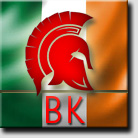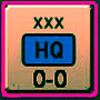wodin
Posts: 10762
Joined: 4/20/2003
From: England
Status: offline

|
Never heard of this man before a Mr Geddes..obviously famous in his time for building some horse race machine in the twenties including rules for breeding and jockeys etc so big that many of the rich and famous used ot go and play. Afterwards he built this...#taken from the Believer Mag.
"Geddes’s War Game—a sequel, of sorts, to the Nutshell—was an idea that dated back to World War I. He’d viewed that slaughter and destruction as a “hopelessly futile” exercise enacted, under the guise of patriotism, by ambitious, willful men, criminals in positions of power. An anti-enlistment pacifist, he was, nevertheless, fascinated by military history and tactical maneuvers. Now, with a second European conflagration brewing, he decided it was time to clear away the mothballs and develop the game in full.
Not for the last time, he had a finger on the zeitgeist. Flagpole-sitting and bathing-beauty contests were on the wane, but the new decade was inspiring a growing national interest in board games (the hugely successful Monopoly allowed would-be entrepreneurs to make a killing that the real economic landscape all but prohibited), more obvious forms of gambling (bingo, the Irish Sweepstakes), and participatory sports (dance marathons, roller derbies, six-day bicycle races). These activities offered escapism, camaraderie, and community—free of politics and religion, and laced with a sense of hope—at a time when large-scale cooperation seemed largely absent.
Though quieter and slower-paced than his horse-race game, the War Game was far more complex. Geddes’s set of rules, cranked out on his faithful printing press, was thick as a phone book. Not one to do things in half measures, he supplemented his research with a personal library of twelve to fifteen hundred books, along with declassified military records, some of which were translated at his request. He also subscribed to the Quartermaster Review and a handful of military journals, including one devoted to cavalry. What had begun modestly, years before, with Rand McNally topographical survey maps pinned to the wall and two chess sets pushed together, now expanded into an alternate universe soon to be frequented by flesh-and-blood five-star generals, retired naval commanders, and international chess champions. This particular “toy” reputedly ended up costing Geddes thirteen thousand dollars out of pocket, a whopping nine-thousand-dollar jump over the Nutshell.
The board was twenty-four feet long and four feet wide, its surface a varnished relief map of the coastline of two imaginary countries. It represented twenty thousand square kilometers, approximately the size of the Western Front. There were a dozen layers of land above sea level, each measuring an eighth of an inch vertically; the water had three measured depths. One journalist reported that nine thousand cities and towns, along with every mountain, valley, tunnel, bridge, and river, were delineated with fictitious names. Pins of various colors, sizes, and shapes (twelve thousand to twenty-five thousand of them, depending on whom one talked to) stood in for forty-plus types of military units. Each pin had a different kind of move, and each occupied the approximate amount of space on the map that its equivalent force would occupy in the field or at sea. There were at least four thousand on the board at all times.
Originally based on World War I technology, the game’s parameters were stretched to include equipment “within the realm of probability”: motorized supply carriers and artillery, PT-like patrol boats, mine sweepers, submarines, tanks and armored cars, machine guns, and landing barges. Geddes had the complete navies of all five leading powers constructed in the model shop of his office. The battleships were built to exact scale (one inch to one hundred feet), complete with brass hulls, armaments, and planes. As time went on, there were also destroyers, aircraft carriers, capital ships and cruisers, tankers, tenders, barges, depot ships, and merchant vessels (ranging from the Queen Mary to a Chinese junk). In all, they would eventually number more than seventeen hundred.
Each country had the same railroad mileage, resources, and imports. Military units moved at speeds contingent upon the terrain they were covering; their artillery’s range (and destructive power) increased a kilometer for every contour level it occupied above its target. The same applied to ships other than patrol boats. Those who found themselves several positions down could rally by sending up aircraft or engaging in other maneuvers. Three dice in a specially designed case were used to determine how much destruction the attacking force might enact when it got within range of an objective.
Each side had a general staff (equipped with maps, charts, typewriters), field commanders, and assorted advisors. But the remarkable thing was that despite there being twenty-eight belligerents—fourteen on each side, simultaneously engaged—there was no need for an umpire. While one side maneuvered, the other watched and conferred among its ranks. A Geddes-designed electric clock, circa 1919—“Before,” he noted “there were any commercially available”—was jury-rigged to tap a ball at ten-minute intervals. Three short warning taps marked twenty-five minutes, and a sharp gong announced the half-hour mark—the other side’s turn.
During each half-hour interval, field commanders could move units and cause them to fire, but only once. Thirty minutes were rarely enough to move more than half one’s forces; much advanced planning and discrimination were required. Stenographers kept score. At the end of the evening, captured enemy pins were placed in coffin-like boxes and handed over to a special secretary, who tabulated the dead (one of every sixty-seven casualties, just as in real wars) and staked them out in graveyards. Wounded troops were returnable in three weeks. Other rules applied to prisoners.
The game ran once a week throughout the winter months, as the Nutshell had in spring and summer. Tuesday nights the battles commenced, or more often continued, from 8 p.m. until midnight. Whereas several horse races had run on any given night, a “war” could last indefinitely. An evening of play was commensurate with three and a half days of war. One conflict dragged on for six months, another for three years. “The battles witnessed by this correspondent were slower than usual,” wrote Richard Massock in his syndicated “About New York” column, noting that an armistice might be the only solution, but then “Geddes explained that several sectors were under the command of recruits who were still learning the rules…”
Sunday was “staff day.” Both sides were allowed to study their opponent’s formation on the board (which, like the Nutshell’s mechanism, was secured beneath a locked plateglass cover to prevent tampering), to make notes, maps, and charts, and to strategize for the following week’s play. This privilege, however, required one to sacrifice five airplanes and climb a ladder to reach the vantage point. According to Dietz, the game’s “associate genius,” Geddes often neglected his professional work in favor of strategizing. He would spend the whole day reading Foch and Joffrey and planning out his tactics.
As with the horse races, players took the proceedings seriously. Tensions tended to run high; faces would redden, lips tighten, fists clench. So much Prohibition liquor was consumed that Geddes was finally reduced to serving water. Many participants wore felt hats, headbands, or eyeshades to keep perspiration from running down their faces, and carried handkerchiefs to dry sweaty hands. Theater critic Bruce Bliven doubled as a referee and war correspondent, madly punching away at a typewriter set up between the opposing sides. Records of every battle were scrupulously kept in huge loose-leaf notebooks. In the game’s early days, Geddes chose to play; his prodigious memory allowed him, one journalist noted, to point out “just wherein the strategic failure was made” during particular battles. Later, he often preferred to watch, pacing up and down “like Jove,” as one reporter said, “overseeing the assault ofTroy.” He saw his creation as an elaborate puzzle “in which a sensitive intellectual could really take an interest.” Dietz described it as chess on a heroic scale, chess “carried to infinity,” a concept seemingly confirmed by the frequent appearance at East Thirty-seventh Street of five-time international chess champion Edward Lasker.
One evening, Geddes’s houseboy announced that someone who couldn’t speak English was at the door. The business card read: Alexander Alexandrovich Alekhine. Alekhine was widely considered chess’s greatest and most inventive player. Lasker, who had competed professionally against the Russian, compared Alekhine’s chess obsession to a morphine addiction. Alekhine had read about the game in a Russian newspaper published in Paris. He was intrigued enough by what he found to return for four consecutive weeks before leaving town.
As commander-in-chief of the Red Force, Edward Lasker subsequently lost an entire field army, his whole command, plus a quarter of his side’s total force; thus failed, he was up for court-martial. The future author of Chess for Fun & Chess for Blood, and an expert at the strategically challenging Japanese board game Go, he threw himself onto Geddes’s sofa and sobbed like a baby. Geddes felt obliged to ban him, but after three months of heartfelt requests he was reinstated.
“It’s a game, of course… but an extraordinary one… A bird’s eye view of modern warfare for players who can see like birds and reason like mathematicians,” crowed the New York Sun. “Navies, complete from battleships to minesweepers… A flight of airplanes is a tiny symbol on a two-inch-long pin stem. Submerged submarines are invisible, but there…”
One morning, a pair of government agents appeared on Geddes’s doorstep, sent from Washington, D.C., to ascertain if the designer was a spy. Geddes obligingly commenced a tour and proceeded to explain the game’s finer points. His guests managed to escape partway through.
The stalwarts forfeited everything from vacations to business and family commitments, returning week after week, month after month. (Some wives came and knitted through the proceedings.) There was a broker, an architect, an underwear manufacturer, a rare-books dealer, and a shipping magnate. Regulars included a member of Woodrow Wilson’s Peace Commission at Versailles, a British brigadier general (retired), an Italian cavalry captain, and the former chief of New York City Detectives. Annapolis football coach Tom Hamilton credited the game for inspiring one of his primary technical strategies. “Had the Kaiser had one of these to work over,” remarked a former German officer, “there wouldn’t have been a war!”
Rear Admiral Frank Friday Fletcher, former commander of the Atlantic Fleet, “flurried the veterans by an incorrigible attack,” noted the New York Times, “disabling a cruiser and three destroyers in one move, at the cost of three squadrons of airplanes. Even the game’s inventor… will [not] be able to tell how the tide of war is flowing for at least a couple more weeks.” Rear Admiral and World War I veteran W. B. Fletcher dropped in of an evening, only to lose eight capital ships. Humiliated, he never came back. Broadway playwright Austin Strong, a veteran of Geddes’s golf game, left under less dramatic circumstances: “I keep thinking about the widows and children,” he said.
As with the Nutshell, rumblings about possible merchandising came to naught. In the mid-’30s, when Geddes finally put the War Game into storage, it was partly, he would claim, because the game’s complexities required having “a school for the recruits.” Between his new industrial-design career and ongoing theater commissions, he simply didn’t have the time. Besides, he’d embarked on a new hobby: amassing hundreds of live reptiles and amphibians for experimentation, study, and to “star” in his elaborate home movies.
The miniaturization and three-dimensional landscaping that Geddes devel for his games made Futurama possible. The War Game’s imaginary countries morphed into a reconfigured United States—California’s coastline juxtaposed with the Mississippi, cities composited, mountain ranges borrowed and shifted—and instead of waxed felt and papier-mâché, as in the past, Futurama’s geographical surfaces were made of a quick-hardening material that various textures could be applied to. Thirty-five thousand square feet were covered “with the stuff used to stuff birds,” presumably excelsior; after asking a taxidermist for twenty-five tons of it, Geddes ended up buying his shop. And along with all the handmade buildings, trees, and silver automobiles, Geddes’s fanatical attention to detail now manifested as “working” waterfalls, low clouds (fashioned with chemical vapors) clinging to mountainsides, and exacting replicas of clotheslines and cow paddies that World’s Fair visitors would never notice. What he called “human interest” details, his workforce referred to as “nuisance architecture.” Much of the crew considered him “nuts.” Geddes got his first look at the on-site office they built for him when the 408-panel model was trucked to the fairgrounds for assembly. The desk was nailed to the floor and a lamp nailed to the desk. There were bars on the window, and the walls were upholstered to resemble a padded cell.
A quarter century after the 1939 World’s Fair, and six years after Geddes’s death, General Motors reprised Futurama as Futurama II for the 1964 New York World’s Fair. Aside from the “updates” of underwater vacation resorts and a trip to the moon, it was the same concept and design. Geddes might well have been proud. Then again, he might have wondered why, after twenty-five years, they hadn’t come up with something even better. He would have."
_____________________________
|
 Printable Version
Printable Version












 New Messages
New Messages No New Messages
No New Messages Hot Topic w/ New Messages
Hot Topic w/ New Messages Hot Topic w/o New Messages
Hot Topic w/o New Messages Locked w/ New Messages
Locked w/ New Messages Locked w/o New Messages
Locked w/o New Messages Post New Thread
Post New Thread